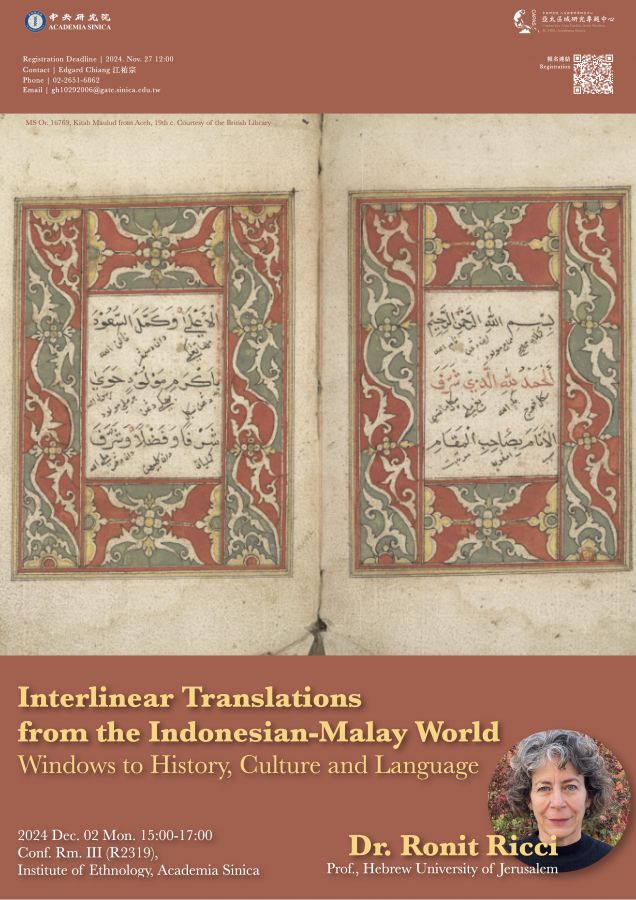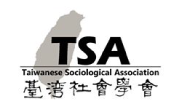中研院亞太中心12/2"Interlinear Translations from the Indonesian-Malay World"專題講座
2024-11-15
會議名稱:2024 跨界與流動專題講座|Interlinear Translations from the Indonesian-Malay World: windows to history, culture and language by Dr. Ronit Ricci
時間:2024年12月02日(週一)14:00-16:00【13:30-14:00報到】
地點:中央研究院 民族學研究所 第三會議室
主辦單位:中研院人社中心亞太區域研究專題中心
報名網址: https://forms.gle/9gEXoukJ3b3oW1wTA
報名截止:2024年11月27日(週三)12:00
演講人:Dr. Ronit Ricci(以色列耶路撒冷希伯來大學 教授)
講題:Interlinear Translations from the Indonesian-Malay World: windows to history, culture and language(英文演講)
Topic: Interlinear Translations from the Indonesian-Malay World: windows to history, culture and language. (will be held in English)
Time: Mon. Dec. 02, 2024 15:00-17:00【14:30-15:00 Registration】
Venue: 3st Conference Rm, Institute of Ethnology, Academia Sinica
Speaker: Dr. Ronit Ricci (Professor, Hebrew University of Jerusalem)
Registration Deadline: 12:00, Weds. Nov. 27, 2024
Organizer: Center for Asia-Pacific Area Studies (CAPAS), RCHSS, Academia Sinica
摘要 Abstract:
Interlinear translation – a bilingual genre that includes a text and its word-for-word ‘equivalents’ in translation written in alternating lines on a single page – has been practiced in diverse societies over many centuries, yet has been little studied. Because it prioritizes detail and precision, the interlinear translation paradigm may tell us more than any other about the workings of translation and the unavoidable choices inherent in every translation act.
The focus of the research project to be presented, titled “Textual Microcosms: A New Approach in Translation Studies,” is on interlinear translations produced between the late 16th and 20th centuries in the Indonesian-Malay world, a historically and culturally linked region now encompassing Indonesia, Malaysia, Brunei, Singapore, southern Thailand and the southern Philippines. One of the world’s most linguistically diverse regions, it has seen Hindu, Buddhist, Confucian, Christian, and Islamic textual traditions locally adopted and adapted over the centuries, often through the interlinear model.
The talk will introduce the project and its approach of such texts as “textual microcosms” that can reveal a host of religious, intellectual, literary, artistic and linguistic processes and encounters as expressed and reflected on the interlinear page.

時間:2024年12月02日(週一)14:00-16:00【13:30-14:00報到】
地點:中央研究院 民族學研究所 第三會議室
主辦單位:中研院人社中心亞太區域研究專題中心
報名網址: https://forms.gle/9gEXoukJ3b3oW1wTA
報名截止:2024年11月27日(週三)12:00
演講人:Dr. Ronit Ricci(以色列耶路撒冷希伯來大學 教授)
講題:Interlinear Translations from the Indonesian-Malay World: windows to history, culture and language(英文演講)
Topic: Interlinear Translations from the Indonesian-Malay World: windows to history, culture and language. (will be held in English)
Time: Mon. Dec. 02, 2024 15:00-17:00【14:30-15:00 Registration】
Venue: 3st Conference Rm, Institute of Ethnology, Academia Sinica
Speaker: Dr. Ronit Ricci (Professor, Hebrew University of Jerusalem)
Registration Deadline: 12:00, Weds. Nov. 27, 2024
Organizer: Center for Asia-Pacific Area Studies (CAPAS), RCHSS, Academia Sinica
摘要 Abstract:
Interlinear translation – a bilingual genre that includes a text and its word-for-word ‘equivalents’ in translation written in alternating lines on a single page – has been practiced in diverse societies over many centuries, yet has been little studied. Because it prioritizes detail and precision, the interlinear translation paradigm may tell us more than any other about the workings of translation and the unavoidable choices inherent in every translation act.
The focus of the research project to be presented, titled “Textual Microcosms: A New Approach in Translation Studies,” is on interlinear translations produced between the late 16th and 20th centuries in the Indonesian-Malay world, a historically and culturally linked region now encompassing Indonesia, Malaysia, Brunei, Singapore, southern Thailand and the southern Philippines. One of the world’s most linguistically diverse regions, it has seen Hindu, Buddhist, Confucian, Christian, and Islamic textual traditions locally adopted and adapted over the centuries, often through the interlinear model.
The talk will introduce the project and its approach of such texts as “textual microcosms” that can reveal a host of religious, intellectual, literary, artistic and linguistic processes and encounters as expressed and reflected on the interlinear page.




